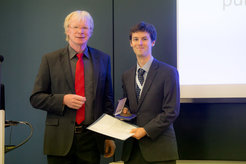Otto Hahn Medal for Dr. Colin Clark
AEI Hannover researcher receives Max Planck Society award for his dissertation
Dr. Colin Clark, researcher at the Max Planck Institute for Gravitational Physics (Albert Einstein Institute; AEI) in Hannover receives one of this year’s Max Planck Society Otto Hahn Medals. The prize for his dissertation about discoveries of new gamma-ray pulsars by improved data analysis methods carries an award sum of €7,500. The award was presented to 30 excellent young Max Planck researchers, including Clark, on 21st of June at the 2017 Annual Meeting of the Max Planck Society in Weimar.

For his dissertation, Clark developed new search methods for gamma-ray pulsars in data from the Fermi gamma-ray space telescope. He then used these methods to discover 19 previously unknown such pulsars during his PhD studies.
“I found developing new methods to make these searches more efficient and more sensitive a rewarding challenge,” says Colin Clark. “It is always very exciting to discover a new signal from a previously mysterious source.”
Mysterious gamma-ray pulsars
Gamma-ray pulsars are rapidly rotating neutron stars, compact stellar remnants about 1.5 times the mass of our Sun and with a diameter of 20 kilometers. Neutron stars are endpoints of stellar “lives”, born from massive stars in supernova explosions. Gamma-ray pulsars emit pulsed gamma-radiation in beams similar to a cosmic lighthouse.
Studying the Galactic neutron star population helps astronomers to better understand how stars evolve. Another open question is how the neutron stars produce their energetic gamma-ray emissions. They appear to be linked to the neutron stars’ extremely strong magnetic fields, which are more than a trillion times stronger than the Earth’s magnetic field.
Compute-intensive blind searches with Einstein@Home

The difficulty in discovering new gamma-ray pulsars arises from the fact that although gamma-ray pulsars are one of the most energetic phenomena in our Universe, their signals are extraordinarily faint when they arrive at Earth.
On average fewer than 10 photons per day are detected from a typical pulsar by the Large Area Telescope onboard the Fermi spacecraft. To detect periodicities, years of data must be analyzed, during which the pulsar might rotate billions of times. For each photon one must determine exactly when during a single split-second rotation it was emitted. This requires searching over years long data sets with very fine resolution in order not to miss a signal. The computing power required for these “blind searches” – when little to no information about the pulsar is known beforehand – is enormous.
One key ingredient to Clark’s discoveries was the use of the distributed computing project Einstein@Home run by the AEI Hannover together with the University of Wisconsin-Milwaukee. The project allows volunteers from all around the world to donate spare compute cycles on their home computers and smartphones to searches for neutron stars. Einstein@Home searches for their gamma-ray emission and radio emission. The main goal of the project is to detect continuous gravitational waves emitted by neutron stars.
The awardee
Dr. Colin Clark (born 1990) studied physics and astronomy at the University of Glasgow and did his PhD studies at the Max Planck Institute for Gravitational Physics in an Emmy Noether research group lead by Dr. Holger Pletsch. He now is a post-doctoral researcher in the “Observational Relativity and Cosmology” division led by Prof. Bruce Allen at the AEI Hannover.
Recognition for excellent junior scientists
Since 1978, the Max Planck Society has been annually honoring young scientists with the Otto Hahn Medal for outstanding scientific achievements, which they have achieved mostly within the framework of their doctoral dissertation. This carries a recognition prize of 7500 Euros. Dr. Colin Clark received this distinction for his dissertation “A Blind-search Survey for Gamma-ray Pulsars”.













